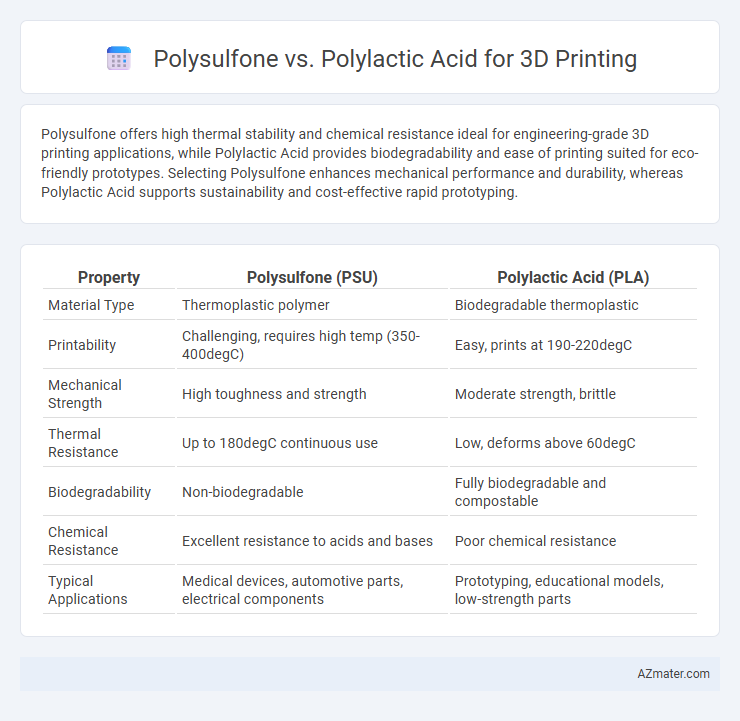Polysulfone offers high thermal stability and chemical resistance ideal for engineering-grade 3D printing applications, while Polylactic Acid provides biodegradability and ease of printing suited for eco-friendly prototypes. Selecting Polysulfone enhances mechanical performance and durability, whereas Polylactic Acid supports sustainability and cost-effective rapid prototyping.
Table of Comparison
| Property | Polysulfone (PSU) | Polylactic Acid (PLA) |
|---|---|---|
| Material Type | Thermoplastic polymer | Biodegradable thermoplastic |
| Printability | Challenging, requires high temp (350-400degC) | Easy, prints at 190-220degC |
| Mechanical Strength | High toughness and strength | Moderate strength, brittle |
| Thermal Resistance | Up to 180degC continuous use | Low, deforms above 60degC |
| Biodegradability | Non-biodegradable | Fully biodegradable and compostable |
| Chemical Resistance | Excellent resistance to acids and bases | Poor chemical resistance |
| Typical Applications | Medical devices, automotive parts, electrical components | Prototyping, educational models, low-strength parts |
Introduction to Polysulfone and Polylactic Acid
Polysulfone (PSU) is a high-performance thermoplastic known for its exceptional heat resistance, mechanical strength, and chemical stability, making it suitable for demanding 3D printing applications. Polylactic Acid (PLA) is a biodegradable, bioactive thermoplastic derived from renewable resources like corn starch, favored for its ease of printing and environmental friendliness. Both materials serve distinct purposes in additive manufacturing, with PSU excelling in durability and high-temperature environments, while PLA offers sustainability and user-friendly processing.
Material Properties Comparison
Polysulfone offers exceptional thermal stability with a continuous use temperature up to 160degC, high chemical resistance, and strong mechanical strength, making it ideal for functional prototypes requiring durability and heat resistance in 3D printing. Polylactic Acid (PLA) is biodegradable, derived from renewable resources with lower thermal resistance around 60degC, and exhibits ease of printing due to low warping, suitable for detailed aesthetic models rather than high-performance applications. The significant difference in tensile strength--polysulfone typically exceeding 50 MPa compared to PLA's 60-70 MPa impacted by crystallinity--and the high glass transition temperature of polysulfone highlight its suitability for industrial parts over PLA's eco-friendly but mechanically limited profile.
Mechanical Strength and Durability
Polysulfone (PSU) offers superior mechanical strength and high thermal stability compared to Polylactic Acid (PLA), making it ideal for functional and high-performance 3D printed parts. PLA exhibits biodegradability and ease of printing but has lower impact resistance and tensile strength, limiting its durability under mechanical stress. PSU's excellent toughness and chemical resistance extend the lifespan of printed components in demanding environments, whereas PLA is better suited for prototyping and low-stress applications.
Printability and Processing Temperatures
Polysulfone offers excellent printability in 3D printing with a high heat deflection temperature around 190-200degC, requiring extrusion temperatures between 350-400degC, making it suitable for high-performance applications needing thermal resistance and chemical stability. Polylactic acid (PLA) provides easier printability at lower extrusion temperatures of 190-220degC and bed temperatures of 50-60degC, ideal for beginners and general prototyping but lacks the thermal endurance of polysulfone. Processing polysulfone demands an enclosed printer environment and advanced handling due to moisture sensitivity, whereas PLA is more forgiving with minimal warp and no heated chamber requirements.
Biocompatibility and Environmental Impact
Polylactic Acid (PLA) is widely recognized for its superior biocompatibility, making it suitable for medical implants and prosthetics due to its biodegradability and low toxicity. Polysulfone (PSU) offers excellent thermal and chemical resistance but has limited biodegradability and poses challenges related to environmental impact due to its petroleum-based origin. Choosing between PLA and PSU for 3D printing involves balancing PLA's eco-friendly, biocompatible properties against PSU's durability and resistance in demanding biomedical applications.
Surface Finish and Detail Resolution
Polysulfone (PSU) offers superior thermal stability and chemical resistance, enabling high-quality surface finishes with smooth, consistent layers ideal for engineering prototypes requiring precision. Polylactic Acid (PLA) provides excellent detail resolution due to its lower printing temperature and minimal warping, making it suitable for intricate decorative models with fine details. Comparing the two, PSU delivers more durable and heat-resistant parts with slightly less fine detail, while PLA excels in producing sharp features and smoother textures in low-stress applications.
Applications in 3D Printing
Polysulfone (PSU) is valued in 3D printing for its high heat resistance, chemical stability, and mechanical strength, making it ideal for functional prototypes and components in aerospace, automotive, and medical devices. Polylactic Acid (PLA), a biodegradable thermoplastic derived from renewable resources, is widely used in 3D printing for rapid prototyping, educational purposes, and consumer products due to its ease of printing and environmental friendliness. While PSU excels in high-performance applications requiring durability and temperature resistance, PLA is preferred for cost-effective and eco-conscious projects with moderate mechanical requirements.
Cost and Availability
Polysulfone is significantly more expensive than polylactic acid (PLA) due to its advanced thermal and chemical resistance, making it less accessible for everyday 3D printing applications. PLA, derived from renewable resources like corn starch, is widely available and cost-effective, popular for both hobbyists and professionals because of its ease of use and affordability. The lower cost and broad availability of PLA filaments make it the preferred choice for large-scale and budget-conscious 3D printing projects, while polysulfone caters to specialized industrial applications requiring high-performance materials.
Pros and Cons: Polysulfone vs Polylactic Acid
Polysulfone offers superior thermal stability and mechanical strength compared to Polylactic Acid, making it ideal for high-performance 3D printing applications requiring heat resistance and durability. Polylactic Acid excels in biodegradability and ease of printing at lower temperatures but suffers from lower impact resistance and limited thermal resilience. Choosing Polysulfone benefits industrial parts needing robustness, while Polylactic Acid suits eco-friendly prototyping and less demanding mechanical uses.
Conclusion: Choosing the Right Material
Polysulfone offers superior thermal stability and chemical resistance, making it ideal for engineering applications requiring durability and high performance in 3D printing. Polylactic Acid (PLA) excels in biocompatibility and environmental sustainability, preferred for prototyping and consumer-grade projects due to its biodegradability and ease of printing. Selecting between Polysulfone and PLA depends on the specific application requirements, weighing factors like mechanical strength, temperature tolerance, and ecological impact to optimize material performance.

Infographic: Polysulfone vs Polylactic Acid for 3D Printing
 azmater.com
azmater.com